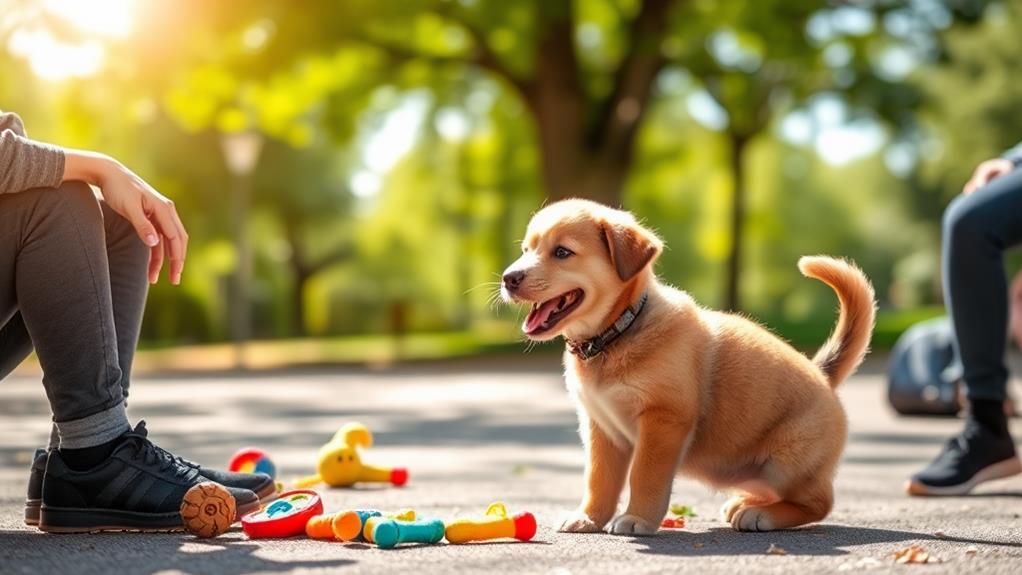To raise a confident dog, use these seven effective training techniques. Start with positive reinforcement to reward good behavior immediately. Focus on socialization with other vaccinated dogs to encourage positive interactions. Expose your puppy to new environments gradually, allowing them to explore. Incorporate clicker training for clear communication of desired actions. Be consistent with commands across your household for better understanding. Engage in reward-based play sessions to make learning enjoyable. Finally, use gradual desensitization to reduce fear of specific stimuli. There's much more to explore about training techniques that can help your puppy thrive and feel secure.
Positive Reinforcement Strategies
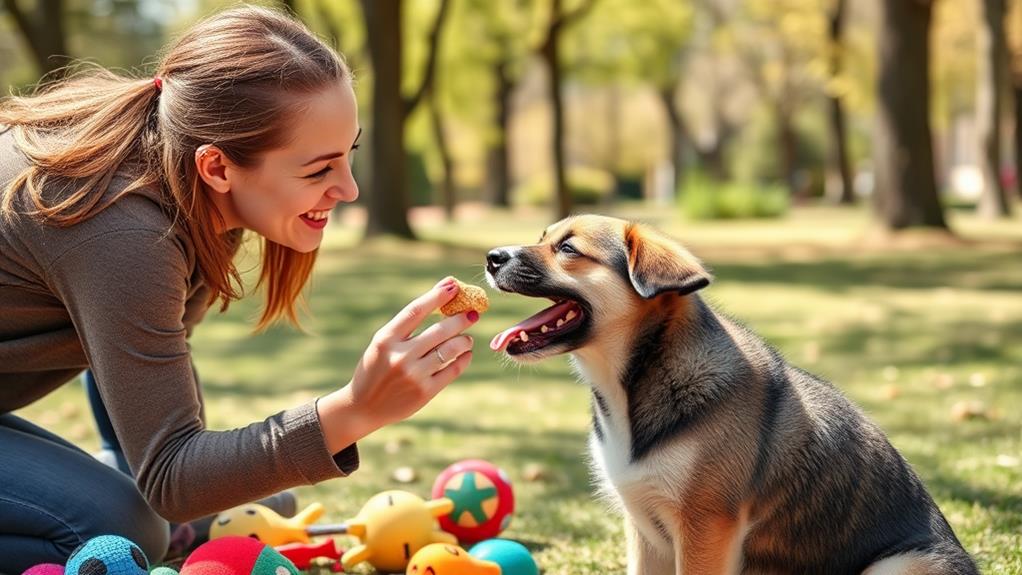
When it comes to training your puppy, using positive reinforcement strategies can really turn things around. Instead of focusing on punishment, you'll want to reward good behavior to encourage your puppy to repeat it. This approach builds trust and strengthens your bond.
Start by identifying the behaviors you want to reinforce, like sitting, staying, or coming when called. Whenever your puppy performs one of these actions, immediately reward them with treats, praise, or affection. Consistency is key; make sure you reward them every time they get it right, especially during the early stages of training.
You can use clicker training as a helpful tool. When your puppy performs the desired behavior, give a click followed by a reward. This creates a clear connection between the action and the reward in your puppy's mind.
Keep training sessions short but frequent to maintain your puppy's attention. It's important to remain patient and upbeat; your enthusiasm will motivate your puppy to engage and learn. Over time, your puppy will understand what behaviors earn rewards, leading to a more confident and well-behaved companion.
Socialization With Other Dogs
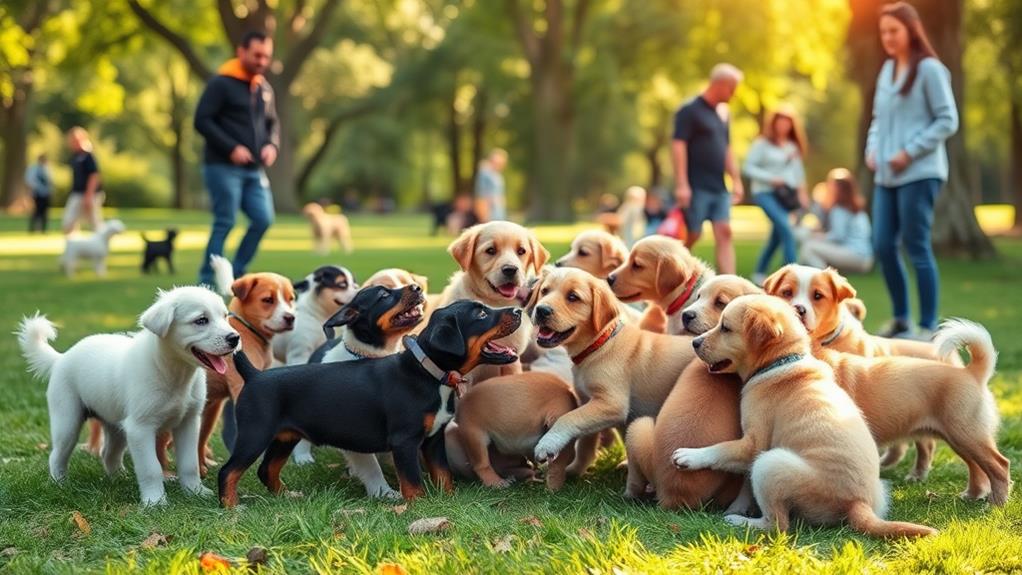
How can you guarantee your puppy grows up to be a well-adjusted adult dog? One of the most effective ways is through socialization with other dogs. By exposing your puppy to various canine companions, you help them learn essential social skills and build confidence.
Start Early: Introduce your puppy to other dogs as soon as they've completed their vaccinations. Early experiences shape their behavior for life.
Choose Positive Playmates: Look for friendly, vaccinated dogs that have a calm demeanor. This helps create a safe environment for your puppy to explore.
Supervise Interactions: Always monitor your puppy during playdates or group classes. This verifies they're safe and can learn appropriate behaviors from observing other dogs.
Reward Good Behavior: Use treats or praise when your puppy interacts positively with others. Reinforcing good experiences encourages them to continue engaging with their peers.
Exposure to New Environments
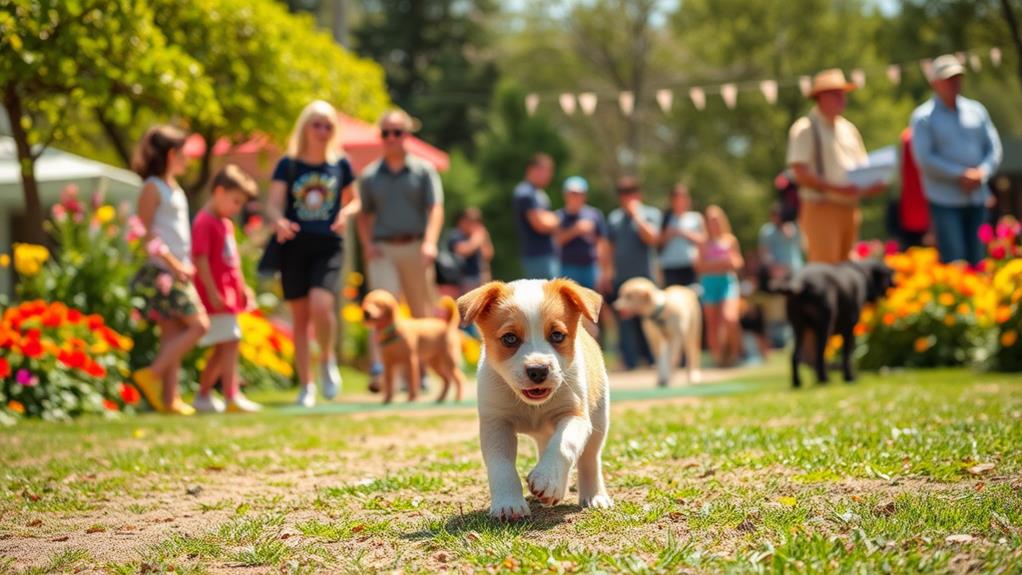
Exposing your puppy to new environments is essential for their development into a confident adult dog. When you introduce your pup to different settings, you help them adapt to various sights, sounds, and smells. This exposure reduces anxiety and builds their resilience to unfamiliar situations.
Start by taking your puppy on short trips to parks, busy streets, or pet-friendly stores. Let them explore these places at their own pace. Encourage curiosity by allowing your pup to sniff around, but keep a close eye on their comfort level. If they seem overwhelmed, give them a break and try another day.
Invite friends or family members over to help your puppy experience new people and interactions. This will enhance their social skills and make them more adaptable. You can also expose your pup to different surfaces, like grass, gravel, or sand, to help them feel secure in their surroundings.
Clicker Training Basics
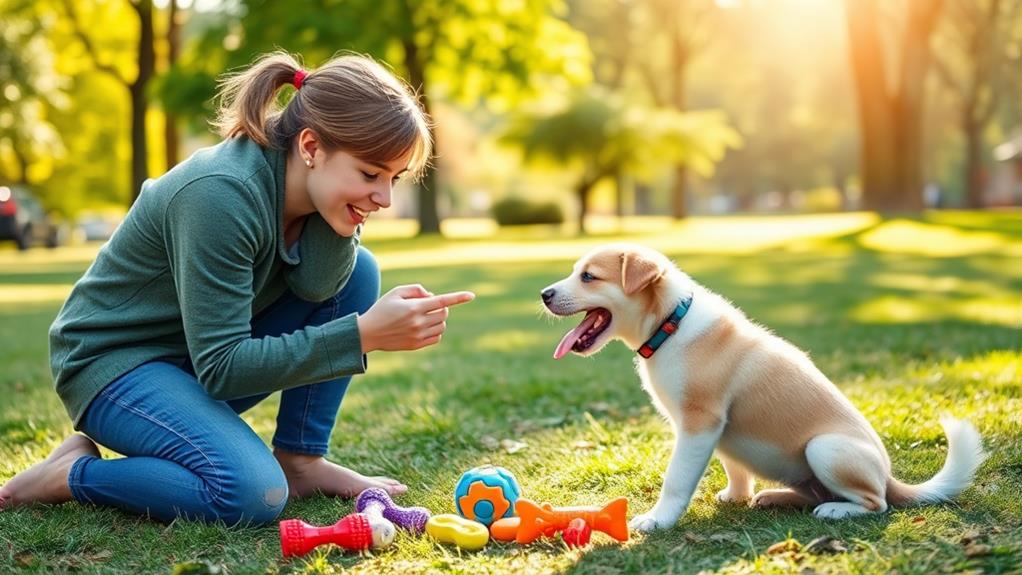
Clicker training is an effective method for teaching your puppy new behaviors and reinforcing good habits. This technique uses a small device that makes a distinct clicking sound, allowing you to mark desired behaviors immediately.
Here's how to get started:
- Get a Clicker: Purchase a clicker from a pet store or online. It should fit comfortably in your hand.
- Charge the Clicker: Before training, click the clicker and immediately give your puppy a treat. Repeat this several times so your puppy associates the sound with a reward.
- Choose a Behavior: Decide on a behavior you want to teach, such as "sit" or "stay." Wait for your puppy to perform that action naturally.
- Click and Reward: As soon as your puppy exhibits the desired behavior, click the clicker and give a treat. This reinforces the action, helping your puppy understand what you want.
Keep training sessions short, around 5-10 minutes, to maintain your puppy's interest. Consistency is key, so practice regularly, and soon your puppy will respond enthusiastically to the clicker!
Consistent Command Training
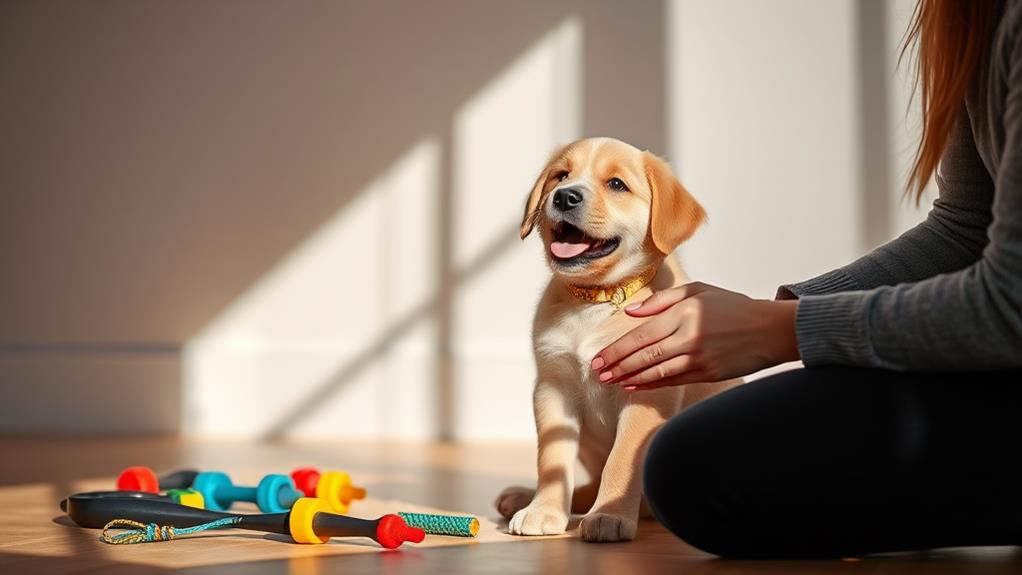
After you've introduced clicker training, it's important to focus on consistent command training to solidify your puppy's understanding of cues. Consistency is key; use the same words and tone for each command. For example, if you're teaching "sit," always say "sit," not "sit down" or "sit please." This helps your puppy link the sound to the action.
Start with a few basic commands like "sit," "stay," and "come." Practice these commands in short sessions, ideally around five to ten minutes, to keep your puppy engaged. Repetition is essential, so practice commands multiple times each day. When your puppy responds correctly, use the clicker to mark the behavior immediately, then follow up with praise or a treat.
Make sure everyone in your household uses the same commands to avoid confusing your puppy. If someone uses different words or gestures, it can lead to mixed signals. Finally, don't forget to be patient. Puppies are learning, and it may take time for them to fully grasp what you want. Keep it positive and fun, and your consistent command training will lay the groundwork for a well-behaved, confident dog.
Reward-Based Play Sessions
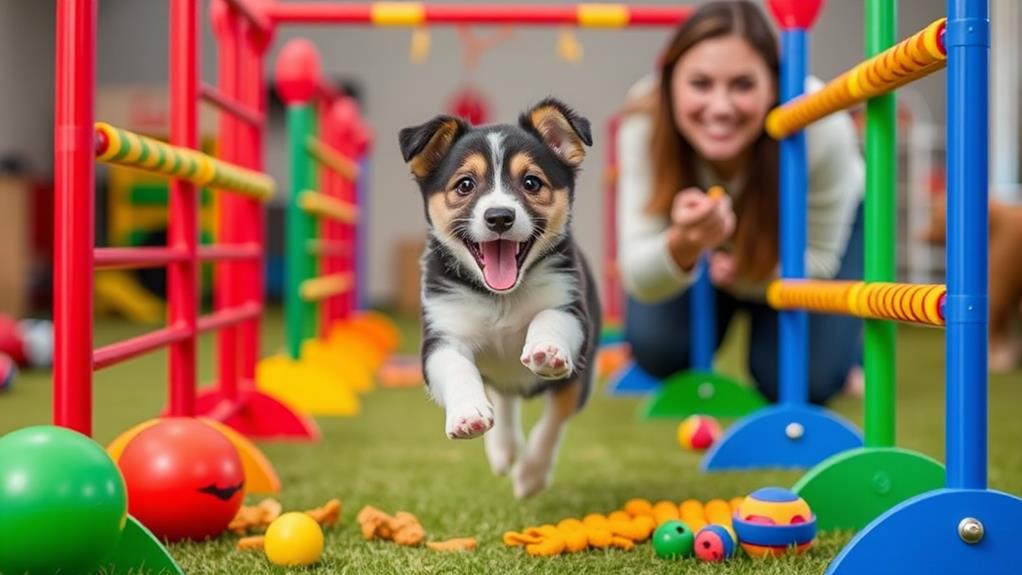
Incorporating reward-based play sessions into your puppy training routine can enhance learning while strengthening your bond. These sessions make training enjoyable for both you and your puppy, turning lessons into fun experiences. When you use rewards during play, your puppy learns to associate positive experiences with specific behaviors.
Use High-Value Rewards: Choose treats or toys your puppy loves to motivate them during play. The excitement of a favorite toy can encourage them to engage more actively.
Incorporate Commands: Integrate commands like "sit" or "fetch" into your play sessions. When your puppy follows through, reward them immediately to reinforce the behavior.
Keep Sessions Short: Limit play sessions to about 10-15 minutes to maintain your puppy's attention and enthusiasm. Frequent, shorter sessions can be more effective than longer ones.
Vary Activities: Mix up the games to keep your puppy engaged. Switch between fetch, tug-of-war, and hide-and-seek to stimulate their mind and body.
Gradual Desensitization Techniques

To help your puppy become more comfortable in various situations, gradual desensitization techniques can be highly effective. This method involves exposing your puppy to a specific stimulus in a controlled manner, allowing them to adjust without overwhelming fear. Start by identifying what your puppy finds stressful, whether it's loud noises, unfamiliar people, or new environments.
Begin with the least intense version of the stimulus. For instance, if your puppy is afraid of loud noises, play a recording at a very low volume while giving them treats and praise. Gradually increase the volume over several sessions, ensuring your puppy remains relaxed.
Always monitor their reactions; if they show signs of stress, reduce the intensity and give them a break. Be patient—this process can take time. Pair the exposure with positive experiences, like playtime or treats, to create positive associations.
Consistency is key. Regular, short sessions will help your puppy build confidence and learn to cope with their fears. With dedication, you'll see your puppy transform into a more confident companion, ready to face the world with ease.
Frequently Asked Questions
What Age Is Best to Start Puppy Training?
You should start puppy training as early as eight weeks old. At this age, your pup's brain is highly receptive, making it easier for them to learn commands and socialization skills that'll shape their behavior.
How Long Should Training Sessions Last?
Training sessions should be short yet impactful. You'll find that 5 to 10 minutes is ideal for keeping your pup engaged and focused. Longer sessions can lead to frustration, so mix it up for success!
Can I Train My Puppy Without Treats?
Yes, you can train your puppy without treats! Use praise, toys, or playtime as motivation. Consistency and positive reinforcement are key, so focus on rewarding good behavior in ways that excite and engage your puppy.
What Should I Do if My Puppy Won't Listen?
If your puppy won't listen, try engaging their attention with toys or play. Consistently use cues, be patient, and guarantee training sessions are fun. Reinforce good behavior with praise, and don't forget to keep practicing.
How Can I Tell if My Puppy Is Stressed?
Like a balloon ready to pop, your puppy shows stress through body language. Look for signs like tucked tails, flattened ears, or excessive panting. If you notice these, it's time to soothe and comfort your furry friend.
Conclusion
Training your puppy doesn't have to be overwhelming. By focusing on these techniques, you'll build a confident and well-adjusted dog. You might worry that your puppy won't respond to these methods, but remember, consistency is key. Each pup learns at their own pace, and with patience and positive reinforcement, you'll see progress. Embrace the journey, celebrate the small wins, and enjoy the bond you're creating. Your efforts will lead to a happy, confident companion!

